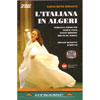Rossini (L') Italiana in Algeri
Zebras and zany ideas: now we can see why the fun was missing
View record and artist detailsRecord and Artist Details
Composer or Director: Gioachino Rossini
Genre:
Opera
Label: Dynamic
Magazine Review Date: 10/2007
Media Format: Digital Versatile Disc
Media Runtime: 150
Mastering:
Stereo
Catalogue Number: DV33526

Tracks:
| Composition | Artist Credit |
|---|---|
| (L')Italiana in Algeri, '(The) Italian Girl in Algiers' |
Gioachino Rossini, Composer
Alex Esposito, Haly, Baritone Barbara Bargnesi, Elvira Bologna Teatro Comunale Orchestra Bruno de Simone, Taddeo, Baritone Donato Renzetti, Conductor Gioachino Rossini, Composer José Maria Lo Monaco, Zulma, Soprano Marco Vinco, Mustafa, Bass Marianna Pizzolato, Isabella, Soprano Maxim Mironov, Lindoro Prague Chamber Choir |
Author: Richard Osborne
Though stylishly conducted and strongly cast, this 2006 revival of Dario Fo’s 1994 Pesaro production of L’italiana in Algeri seemed strangely bereft of comic élan in the CD version (Dynamic, 4/07). Why was this? Did Fo’s production corral the singers and bore the audience?
The DVD provides a somewhat equivocal answer. During Act 1 the principals do indeed find themselves marooned amid a menagerie of pantomime animals and a troop of largely irrelevant extras. Act 2, by contrast, is cleverly staged and beautiful to look at.
Listening to the CDs, I had wondered why Marianna Pizzolato made virtually nothing of Isabella’s celebrated exclamation “O che muso!” (“Oh what a mug!”) when she first sets eyes on Mustafà. The answer is, she isn’t looking at him. Fo is too busy whirling the singers round the stage in wicker-work flying machines. I also wondered why, with so accomplished a stage comedian as Bruno de Simone as Isabella’s elderly admirer Taddeo, the great duet “Ai capricci” wasn’t more focused. The answer here is: zebras. Zebras and the fact that, again, Fo makes no attempt to replicate in human terms the comedy that is playing out in Rossini’s music.
It is not until the Act 1 finale that he begins to engage with the opera. The recognition scene between Isabella and Lindoro is beautifully staged and lit. The famous stretta (“din din, tac tac, cra cra, bum bum”) would have worked wonderfully if Fo had stuck with the dumb show behind the gauze. But no, the pantomime animals have to come ambling in, along with a troupe of (not very competent) jugglers. The great set-piece ensembles of Act 2 are more economically staged, Fo helping his Isabella, rather than hindering her as he does for most of Act 1, by making her the still centre of the arias “Per lui che adoro” and “Pensa alla patria”. (There is a completely irrelevant Tour de France style pile-up in the latter, with the bicycles not the riders “wittily” carried off on stretchers, but that is Fo’s only aberration.) The scene-within-a-scene as the lovers set sail for Italy is visually memorable.
A curate’s egg of a production, then. Jean-Pierre Ponnelle’s Metropolitan Opera staging, with Marilyn Horne as Isabella (DG, 7/07), is the safer buy.
The DVD provides a somewhat equivocal answer. During Act 1 the principals do indeed find themselves marooned amid a menagerie of pantomime animals and a troop of largely irrelevant extras. Act 2, by contrast, is cleverly staged and beautiful to look at.
Listening to the CDs, I had wondered why Marianna Pizzolato made virtually nothing of Isabella’s celebrated exclamation “O che muso!” (“Oh what a mug!”) when she first sets eyes on Mustafà. The answer is, she isn’t looking at him. Fo is too busy whirling the singers round the stage in wicker-work flying machines. I also wondered why, with so accomplished a stage comedian as Bruno de Simone as Isabella’s elderly admirer Taddeo, the great duet “Ai capricci” wasn’t more focused. The answer here is: zebras. Zebras and the fact that, again, Fo makes no attempt to replicate in human terms the comedy that is playing out in Rossini’s music.
It is not until the Act 1 finale that he begins to engage with the opera. The recognition scene between Isabella and Lindoro is beautifully staged and lit. The famous stretta (“din din, tac tac, cra cra, bum bum”) would have worked wonderfully if Fo had stuck with the dumb show behind the gauze. But no, the pantomime animals have to come ambling in, along with a troupe of (not very competent) jugglers. The great set-piece ensembles of Act 2 are more economically staged, Fo helping his Isabella, rather than hindering her as he does for most of Act 1, by making her the still centre of the arias “Per lui che adoro” and “Pensa alla patria”. (There is a completely irrelevant Tour de France style pile-up in the latter, with the bicycles not the riders “wittily” carried off on stretchers, but that is Fo’s only aberration.) The scene-within-a-scene as the lovers set sail for Italy is visually memorable.
A curate’s egg of a production, then. Jean-Pierre Ponnelle’s Metropolitan Opera staging, with Marilyn Horne as Isabella (DG, 7/07), is the safer buy.
Discover the world's largest classical music catalogue with Presto Music.

Gramophone Digital Club
- Digital Edition
- Digital Archive
- Reviews Database
- Full website access
From £8.75 / month
Subscribe
Gramophone Full Club
- Print Edition
- Digital Edition
- Digital Archive
- Reviews Database
- Full website access
From £11.00 / month
Subscribe
If you are a library, university or other organisation that would be interested in an institutional subscription to Gramophone please click here for further information.




